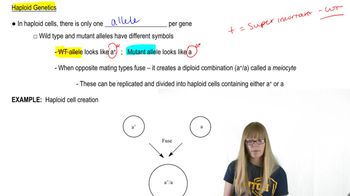Table of contents
- 1. Introduction to Genetics51m
- 2. Mendel's Laws of Inheritance3h 37m
- 3. Extensions to Mendelian Inheritance2h 41m
- 4. Genetic Mapping and Linkage2h 28m
- 5. Genetics of Bacteria and Viruses1h 21m
- 6. Chromosomal Variation1h 48m
- 7. DNA and Chromosome Structure56m
- 8. DNA Replication1h 10m
- 9. Mitosis and Meiosis1h 34m
- 10. Transcription1h 0m
- 11. Translation58m
- 12. Gene Regulation in Prokaryotes1h 19m
- 13. Gene Regulation in Eukaryotes44m
- 14. Genetic Control of Development44m
- 15. Genomes and Genomics1h 50m
- 16. Transposable Elements47m
- 17. Mutation, Repair, and Recombination1h 6m
- 18. Molecular Genetic Tools19m
- 19. Cancer Genetics29m
- 20. Quantitative Genetics1h 26m
- 21. Population Genetics50m
- 22. Evolutionary Genetics29m
17. Mutation, Repair, and Recombination
Induced Mutations
Problem 29b
Textbook Question
A wild-type culture of haploid yeast is exposed to ethyl methanesulfonate (EMS). Yeast cells are plated on a complete medium, and 6 colonies (colonies numbered 1 to 6) are transferred to a new complete medium plate for further study. Four replica plates are made from the complete medium plate to plates containing minimal medium or minimal medium plus one amino acid4 (replica plates numbered 1 to 4) with the following results: For colonies 1, 3, and 5, write '+' for the wild-type synthesis and '−' for the mutant synthesis of histidine and leucine.
 Verified step by step guidance
Verified step by step guidance1
Step 1: Understand the experimental setup. The yeast cells are exposed to EMS, a mutagen, and then plated on a complete medium where all necessary nutrients are provided.
Step 2: Recognize that the replica plates are used to test the ability of the colonies to grow on minimal medium, which lacks certain nutrients, or minimal medium supplemented with specific amino acids.
Step 3: Analyze the growth pattern of colonies 1, 3, and 5 on the replica plates. Growth on minimal medium indicates wild-type synthesis of the required nutrients, while lack of growth indicates a mutation affecting synthesis.
Step 4: Determine the synthesis capability for histidine and leucine for each colony. If a colony grows on minimal medium without supplementation, it synthesizes both amino acids ('+'). If it only grows on medium supplemented with histidine or leucine, it cannot synthesize that amino acid ('−').
Step 5: Record the synthesis status for histidine and leucine for colonies 1, 3, and 5 based on their growth patterns on the replica plates.
Recommended similar problem, with video answer:
 Verified Solution
Verified SolutionThis video solution was recommended by our tutors as helpful for the problem above
Video duration:
1mPlay a video:
Was this helpful?
Key Concepts
Here are the essential concepts you must grasp in order to answer the question correctly.
Haploid Organisms
Haploid organisms, such as yeast, have a single set of chromosomes, which means they possess only one allele for each gene. This genetic simplicity allows for straightforward observation of mutations, as any change in phenotype directly reflects a change in genotype. In experiments, haploid yeast can be used to study gene function and the effects of mutagens like ethyl methanesulfonate (EMS).
Recommended video:
Guided course

Haploid Genetics
Mutagenesis
Mutagenesis is the process by which the genetic information of an organism is changed, resulting in mutations. Ethyl methanesulfonate (EMS) is a chemical mutagen that induces point mutations, often leading to changes in amino acid sequences of proteins. Understanding mutagenesis is crucial for interpreting the effects of EMS on yeast colonies, particularly in relation to their ability to synthesize essential amino acids.
Recommended video:
Guided course

Induced Mutations
Amino Acid Synthesis Pathways
Amino acid synthesis pathways are biochemical routes through which organisms produce amino acids from simpler compounds. In yeast, the ability to synthesize amino acids like histidine and leucine is essential for growth on minimal media. The presence of mutations can disrupt these pathways, leading to a requirement for external sources of these amino acids, which is critical for analyzing the results of the experiment.
Recommended video:
Guided course

Translesion Synthesis

 4:29m
4:29mWatch next
Master Induced Mutations with a bite sized video explanation from Kylia Goodner
Start learningRelated Videos
Related Practice

